
Quickly to the right hardware equipment …
ASRock Z390 Extreme4 Layout, Design and Features
ASRock Z390 Extreme4 Equipment and other features
ASRock Z390 Extreme4 Expansion cards
ASRock Z390 Extreme4 Memory
ASRock Z390 Extreme4 Hard disk drive connectors
ASRock Z390 Extreme4 USB and Firewire
ASRock Z390 Extreme4 Network
ASRock Z390 Extreme4 Sound
ASRock Z390 Extreme4 ATX back panel connectors
ASRock Z390 Extreme4 PC System
Layout, Design and Features …
Here you can see a 360 degree view of the ASRock Z390 Extreme4 ATX motherboard.

And here is the ASRock Z390 Extreme4 Unboxing Video from our OCinside YouTube Channel:
Note: Please allow our cookies first to see this external content!
The black/grey ASRock Z390 Extreme4 High Density fiberglass Sapphire Black PCB board makes a great impression. The motherboard features Premium 60A Power Chokes, Dual-Stack MOSFET (DSM), Nichicon 12K Black Caps capacitors, 12 Power Phase Design and 7.1 HD Audio via the ALC1220.
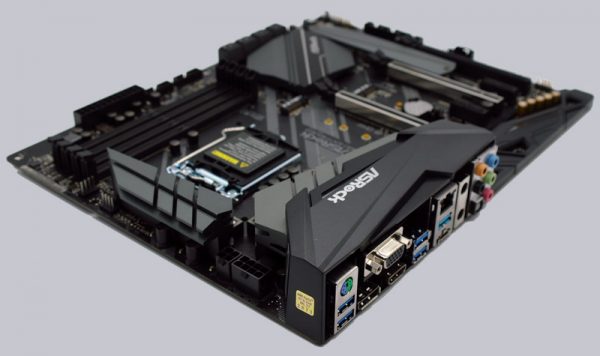
The ASRock Z390 Extreme4 offers like the previously tested ASRock H370 Performance two fast Ultra M.2 slots for PCIe Gen3 x4 modules with up to 32 Gb/s connection and a simple M.2 Key E e.g. for a WiFi module. The following picture shows the six PCIe 3.0 slots and the three M.2 slots, whereby the lower M.2 socket was even equipped with a heat sink.
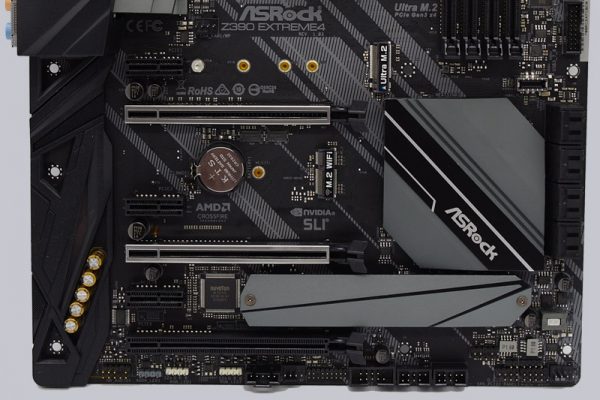
We tested the Z390 Extreme4 with a Plextor M8SeGN 512GB M.2 NVMe SSD, as you can see on the picture with the disassembled M.2 heatsink and we’ll show the M.2 heatsink cooling results in the next SSD review.
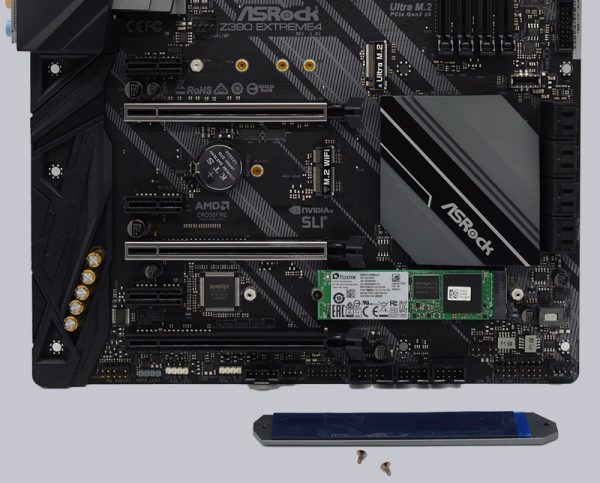
ASRock has also done a lot when it comes to RGB lighting. You can connect conventional 5050 RGB strips to the two white 4-pin 12V RGB headers as usual, for example to illuminate the housing. And best of all, there is now even a Polychrome RGB connector that supports individually addressable LEDs with addressable RGB stripes via the WS2812B.
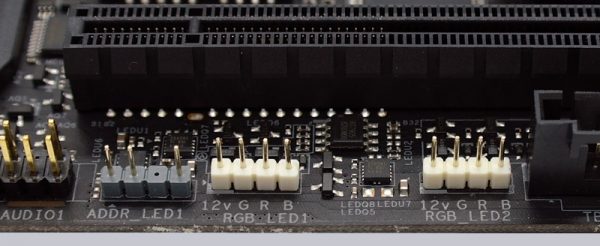
ASRock has integrated several RGB LEDs under the chipset cooler, on the I/O cover and on the audio area of the Z390 Extreme4, which can be controlled as desired.
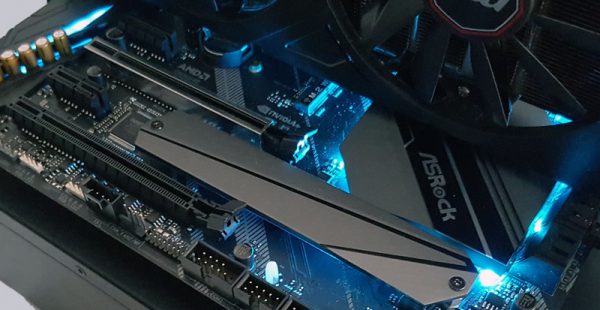
The RGB headers and the integrated RGB LEDs are controlled by the supplied ASRock RGB LED software. For example, you can select the colors in an RGB color selector and set whether the RGB headers should be controlled separately or together with the RGB lighting under the chipset cooler, the IO cover and the audio area. The lighting can of course also be completely deactivated or used for all connections at the same time.
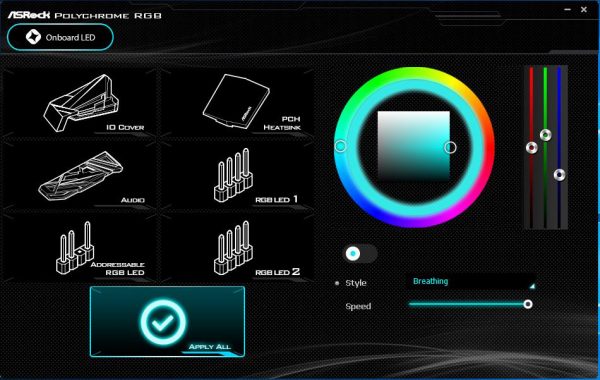
You can select many effects in the ASRock RGB LED menu, for example whether the LEDs should light up continuously, breathe, randomly or be controlled by music and with the addressable RGB connector you even get completely new RGB features like Spring, Meteor, Stack, Cram, Rainbow, etc…
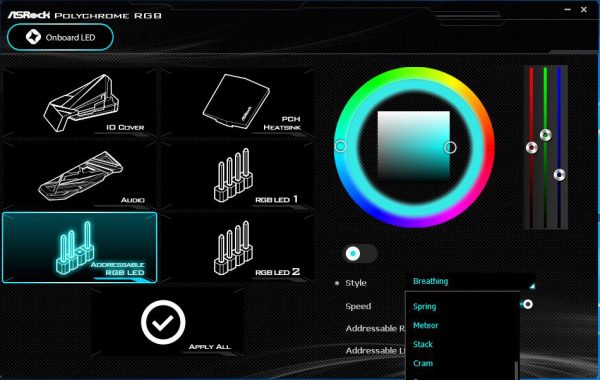
So you get lots of great RGB effects, which we presented in ASRock Polychrome RGB Software Video on our OCinside YouTube Channel.
Note: Please allow our cookies first to see this external content!
In total you can address up to 100 LEDs individually.
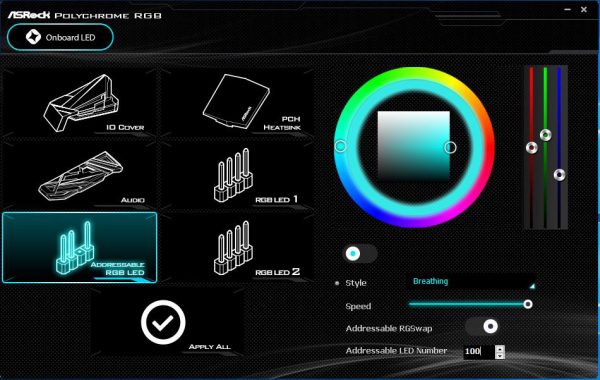
But let’s get back to the equipment first. On the left you can see the front USB 3.1 Gen1 Type-C connector, next to it two internal USB3.1 Gen1 connectors, some Nichicon capacitors and the 24-pin ATX power connector.
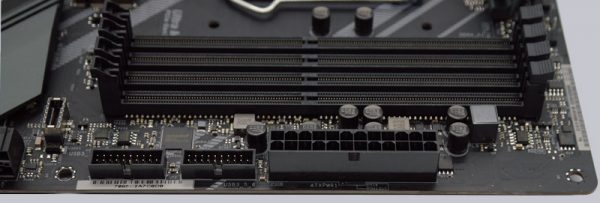
The picture shows the side view of the motherboard with the large heatsink on the MOSFETs.

Here you can see again the two aluminium heatsinks which are placed on the voltage converters together with the heat conduction pad.
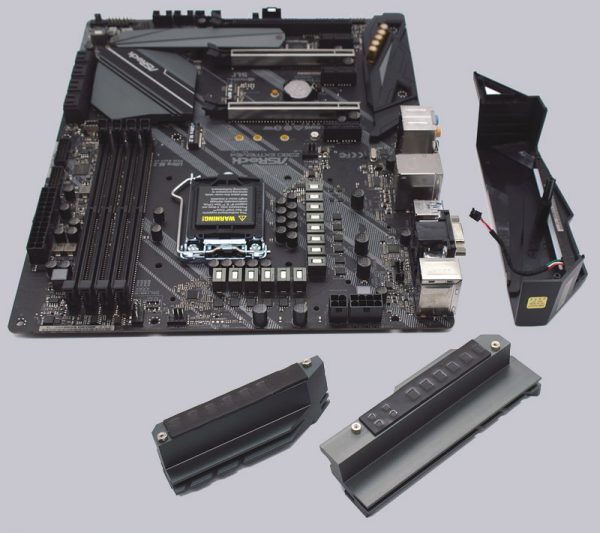
Under the heat sinks of the ASRock Z390 Extreme4 the so-called Smart Power Stage area is cooled.
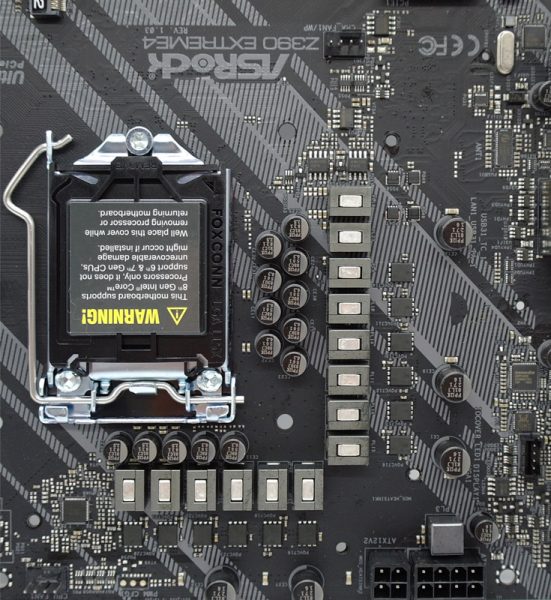
Here you can see again the MOSFETs which are responsible for the power supply of the Intel Coffee Lake or Intel Coffee Lake Refresh CPU.
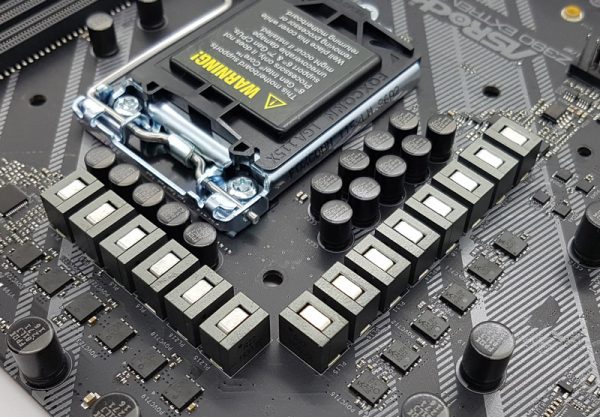
Altogether ASRock uses 12 Sinopower SM7341EH MOSFETs as VRM to the 60A coils.
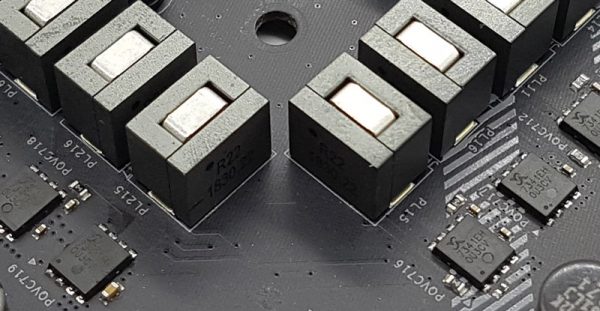
Equipment and other features …
The ASRock Z390 Extreme4 has numerous features, such as the ASRock A-Tuning Tool, ASRock Instant Flash, ASRock Internet Flash, ASRock Easy RAID Installer, 12 Power Phase Design, Digi Power, RGB, Polychrome RGB and ASRock FAN-Tastic Tuning.
Expansion cards …
The motherboard offers three PCI Express 3.0 x16 slots for AMD CrossFireX or nVidia SLI as well as three PCI Express 3.0 x1 slots.
Memory …
The ASRock Z390 Extreme4 Board can be equipped with up to four DDR4 modules and can be upgraded up to a maximum of 64 GB RAM depending on the operating system used (see list). Here you can see a picture of the four DDR4 memory slots with Dual Channel Support:
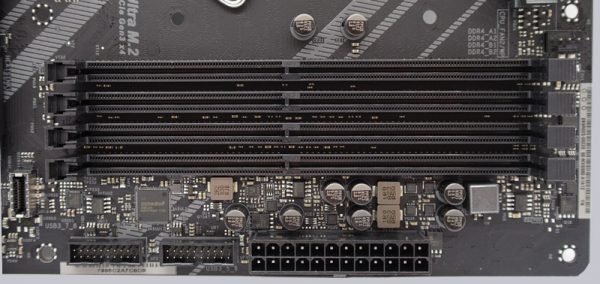
The Intel LGA 1151v2 motherboard supports DDR4 memory modules and can be optimized in the BIOS for DDR4-2666 Quad Channel modules. The UEFI offers adaptations from DDR4-800 up to DDR4-8400.
Thanks to XMP support (Extreme Memory Profile), XMP memory modules are set correctly with a mouse click in the UEFI, but more about this later. Which exact RAM modules are officially supported, one should read before the purchase at ASRock on the memory support page.
Hard disk connectors …
The ASRock Z390 Extreme4 offers a total of eight angled SATA3 ports.
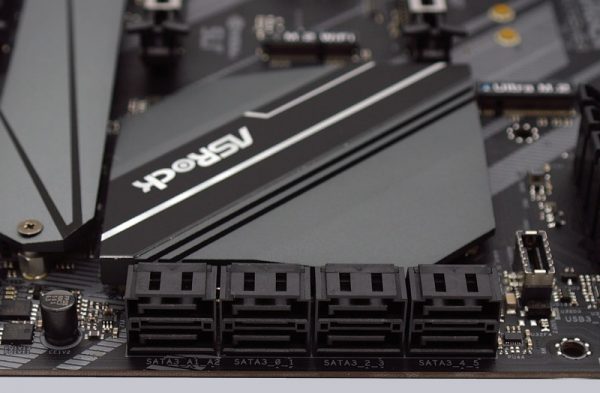
The SATA3 ports support RAID 0, RAID 1, RAID 5, RAID 10, NCQ, AHCI and the Hot Plug function in AHCI mode (AHCI stands for Advanced Host Controller Interface and should be selected for SSDs in UEFI). Thanks to UEFI BIOS, drives with more than 2TB can also be used for the installation of Windows 10 x64. The installation of the drivers ran without problems in Windows 10, so that the 64 bit Windows 10 installation was quickly done.
The RAID drivers can be installed via the Easy RAID Installer point in the UEFI. The drivers for Windows 10 are delivered on DVD and are also available for download on the ASRock Support page, whereby the Windows 10 installation is currently preferred.
USB and Firewire …
The ASRock Z390 Extreme4 has four USB 3.0 ports (USB 3.1 Gen1) and two USB 3.1 Gen2 ports on the ATX panel. On the picture you can see the USB 3.1 Gen2 type-A at the top and the USB 3.1 Gen2 type-C port (pluggable on both sides) at the bottom.
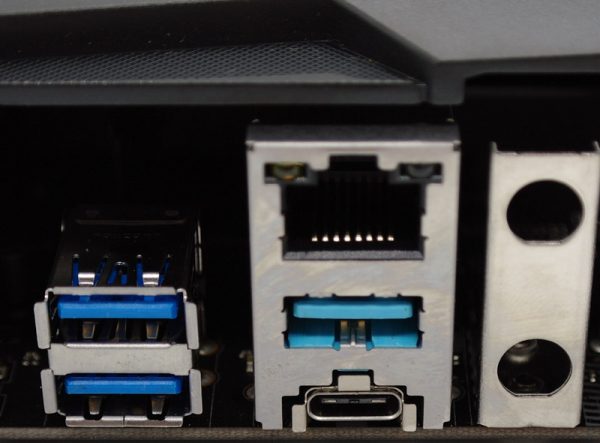
Internally two USB 2.0 ports for up to four optional USB ports and two USB 3.0 headers for up to four optional USB 3.0 ports (USB 3.1 Gen1) are available. The 20-pin header can be connected either to an optional USB3.0 front panel or to a housing with USB3.0 support. New is the Front USB 3.1 Gen1 Type-C port, which allows you to connect 5 Gbps to the front panel of the case.
For Windows 7 there is currently no Intel Z390 support! You can install Microsoft Windows 7 without problems with the Intel Z390 chipset, but the USB ports do not work and there are no drivers for the internal GPU yet. We have tried our way through the tests with a PS/2 keyboard and tried different Windows 7 drivers, but without success. The problem is that the new Z390 chipset has native USB3.1 and USB2.0 support and older Windows 7 drivers no longer work for the USB controllers of the Intel Z390 PCH. Even if one should install Windows 10 nowadays anyway, the official Windows 7 support from Microsoft is actually only obsolete in January 2020. Whether and when there will be drivers for Windows 7 remains to be seen.
Network …
The ASRock Z390 Extreme4 is equipped with the Intel I219V, with which the 10/100/1000 network port on the ATX panel is realized. The LAN port is WoL capable, offers LAN cable detection, supports power efficient Ethernet according to the 802.3az standard, PXE and more.
Sound …
The ASRock Z390 Extreme4 motherboard also features the better Realtek ALC1220 Audio Codec with Content Protection, 120dB SNR DAC, TI NE5532 Premium Headset Amplifier and Purity Sound 4, which supports 7.1 Surround Sound and outputs it analog via 5x 3.5mm jacks on the ATX panel or via the internal front panel audio connector. Furthermore there is an optical SPDIF digital output and Premium Blu-Ray support. Thus an additional sound card with digital outputs is unnecessary for most users.
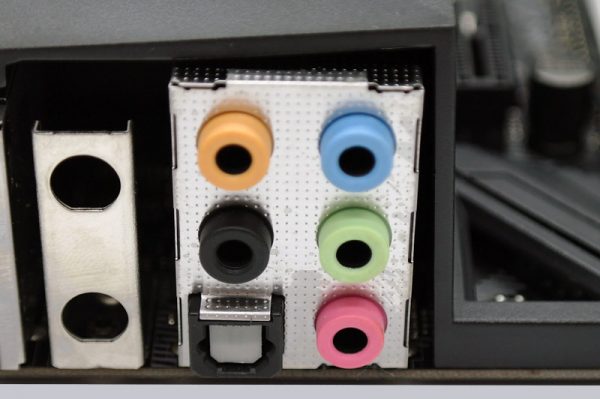
ATX Backpanel connections …
From left to right you can see the 1x PS/2 connector for PS/2 keyboard or PS/2 mouse and 2x USB 3.1 Gen1 (USB 3.0), D-Sub and Displayport 1.2, HDMI, 2x USB 3.1 Gen1 (USB 3.0), RJ45 Gigabit LAN and 1x USB 3.1 Gen2 Type-A and 1x USB 3.1 Gen2 Type-C, the empty WiFi antenna panel, optical SPDIF output and 5x 3.5mm jacks for the sound.

Test System …
Now we come to the Intel LGA 1151 v2 CPU socket. The 8th Gen socket and the 9th Gen socket looks like the LGA1151 socket of the previous generation, but cannot be equipped with Kaby Lake processors like the Intel Core i5-7600K! A new Intel Coffee Lake processor must be installed for it to work on the Intel Z390 board. The socket is equipped with a lever that presses the relatively small CPU evenly onto the pins in the socket. As always during installation, do not touch the contacts or even bend the contacts in the base and during storage or transport, be sure to mount the protective cap on the base. If the pins are bent and the motherboard doesn’t work anymore, we help with words and deeds in Intel Forum. We have equipped the test system with an Intel Core i7-8700K CPU.
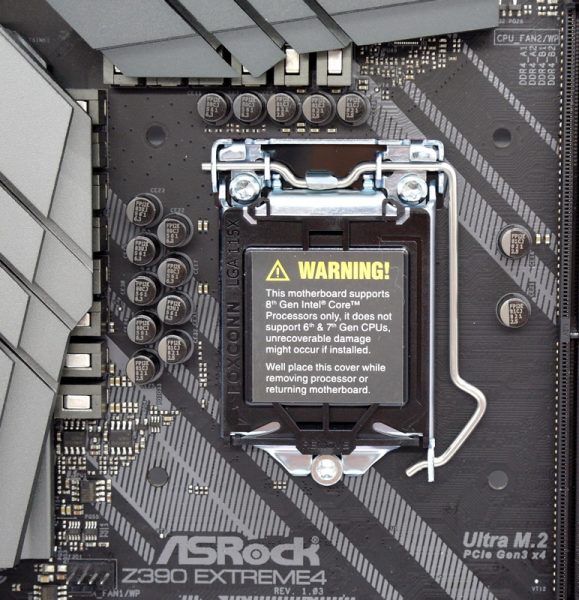
We have equipped the test system with an Intel Core i7-8700K CPU.
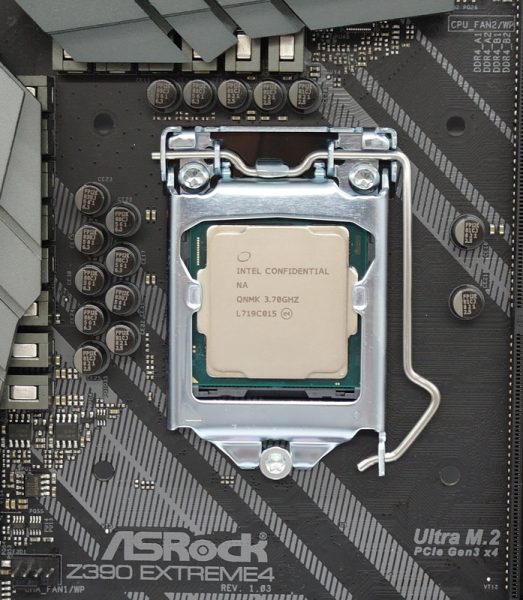
Intel Core i7-8700K CPUs unfortunately do not support Quad Channel Mode, but only Dual Channel Mode. This way the two memory modules are installed on the Intel Z390 motherboard to get Dual Channel support.
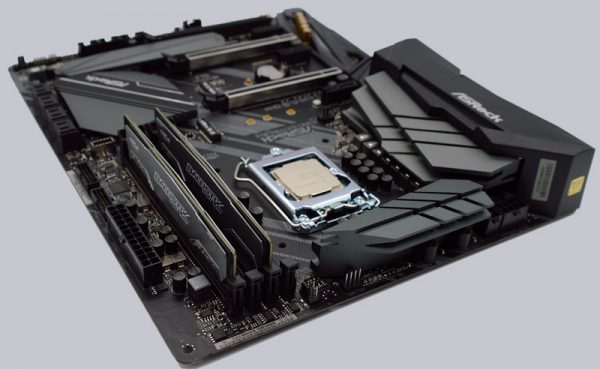
Here you can see again the two DDR4-2400 4GB modules from Crucial in the ASRock Z390 Extreme4 motherboard.
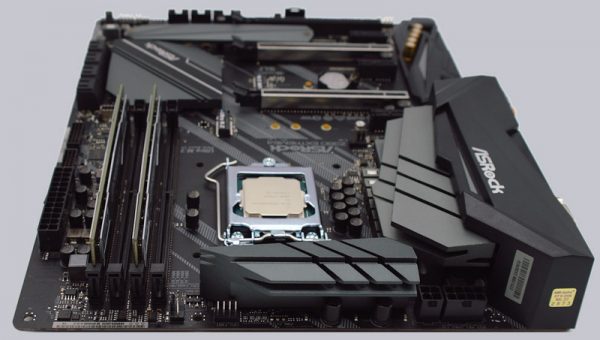
For tests with the new Intel LGA 1151-2 processors we use the Enermax ETS-T50 AXE DFP air cooler. Here you can see the finished Intel LGA 1151 v2 test system from above with Enermax ETS-T50 AXE DFP cooler without graphics card for a better representation of the illumination possibilities at the chipset, IO cover and audio area.
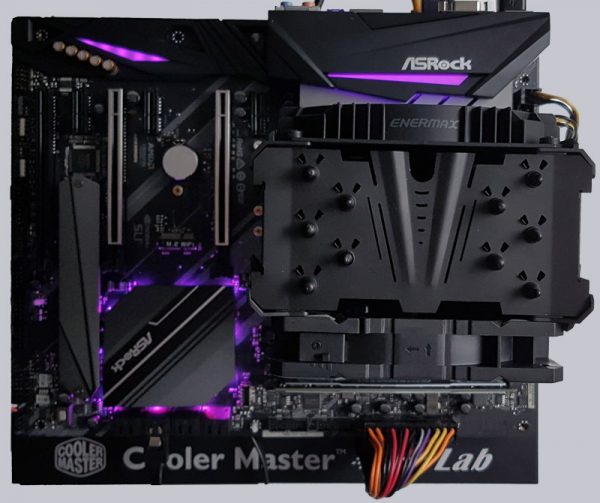
And here you can see a frontal view of the test system with the MSI Radeon R9 280 graphics card and the Icy Dock MB171SP-B Turbo Swap frame for a quick exchange of the SSD or HDD.
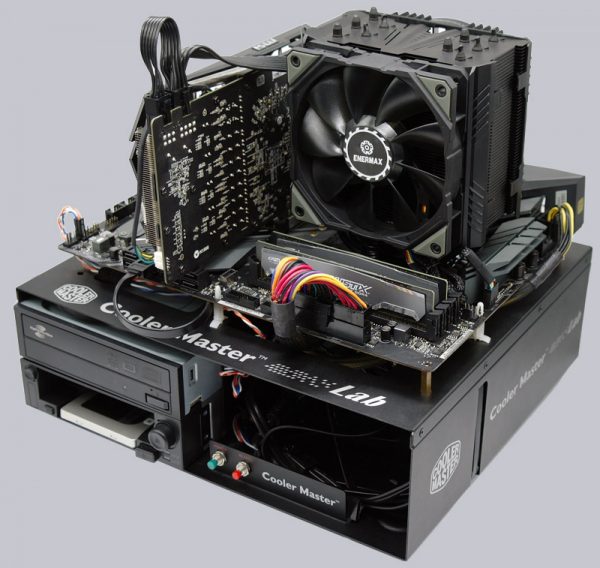
This is what the 6 cores (12 threads) of the Intel Core i7-8700K CPU look like in Windows 10 Task Manager at Prime95 full load.
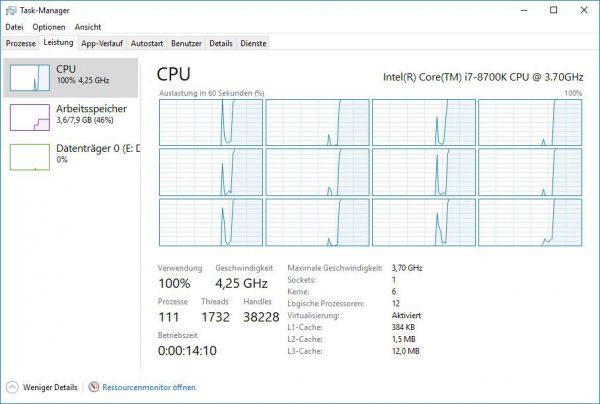
And on the following thermal image you can see the entire heat dissipation of the ASRock Z390 Extreme4 motherboard on the test system.
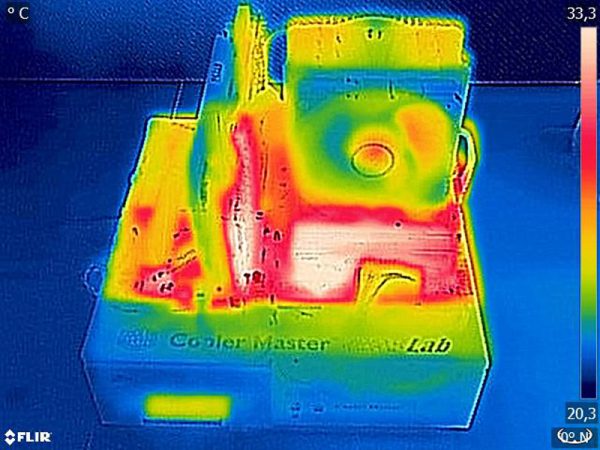
As you can see on the thermal image of the ASRock Z390 Extreme4 PC, the heat dissipation of the voltage regulators and coils through the two heat sinks is very good.
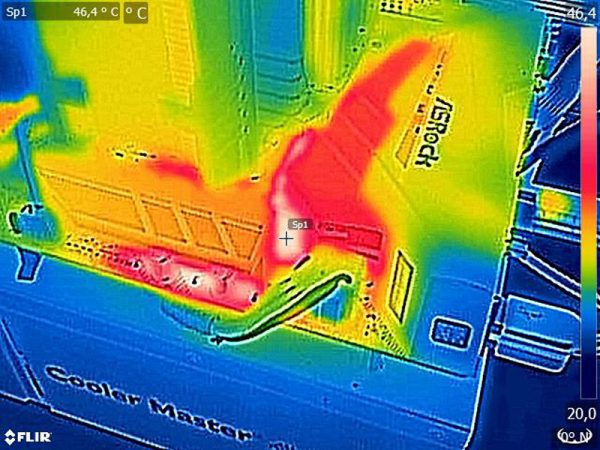
ASRock Z390 Extreme4 BIOS and Overclocking …

